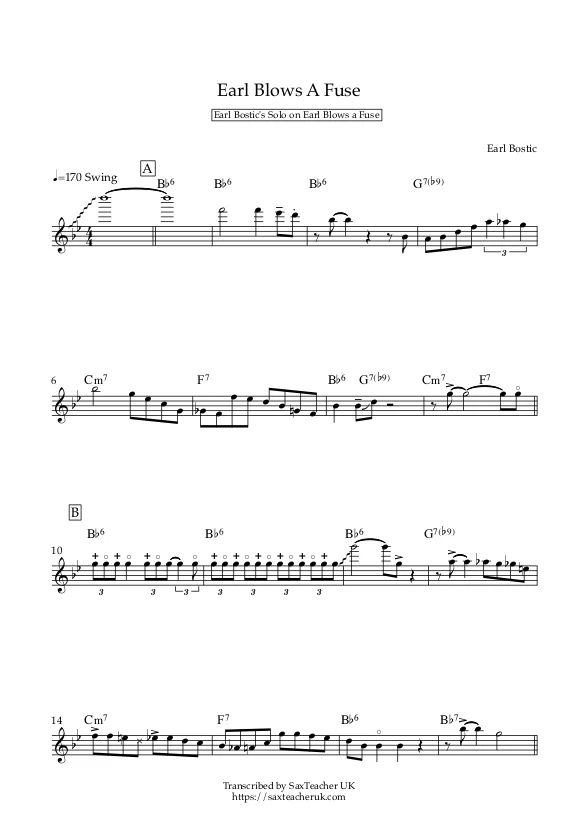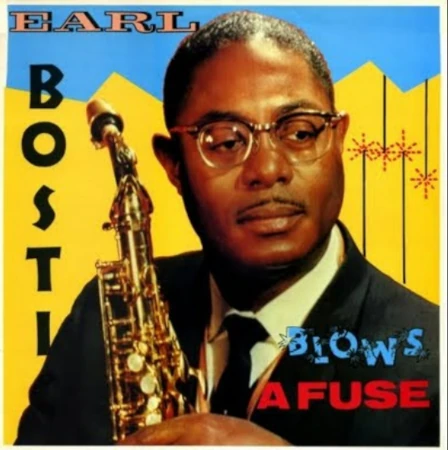Earl Bostic Transcription
Earl Blows a Fuse
Transcriptions Home > Transcription

Listen to the recording with the score on Youtube
Download full transcription for Alto Saxophone
I'm very excited to present the next artist in our transcription series, the hugely underrated Earl Bostic. Earl was a huge influence on the great Charlie Parker, particularly rhythmically and in his extremely creative use of accents. Earl Bostic also develop the art of improvisation on from Lester Young by introducing greater chromaticism to the melodic line - further developed by Parker.
Bostic was an unparalleled Rhythm and Blues player and formulated much of the language that was taken forward by later players such as Stanley Turrentine. He added the signature growl to his sound in the second period of his career, which is judiciously on display in today's solo 'Earl Blows a Fuse,' one of the most exciting solos I've ever heard. This solo is on the chord changes to 'Stompin at the Savoy.'
Earl Bostic's Playing Style
Looking retrospectively Bostic defines the history of the alto saxophone by bridging the gap from Johnny Hodges to Charlie Parker. He makes use of repeated rhythmic hooks with variations to draw the listener in, as can be heard on Hodges' "Blues O' Mighty" solo. Also developed from Johnny Hodges is his varied use of glisses including the KILLER two octave gliss at the start of 'Earl Blows a Fuse.' What a way to launch your solo! Bostic's use of triplets and pentatonic language are extensions of how Rabbit used to play, but with greater chromatic sophistication and relation to the underlying chord tones. This harmonic approach was further developed and extended by Charlie Parker. Compare bar 6 of 'Earl Blows a Fuse' to the break on Parker's 'Groovin High' solo from 'Live at Carnegie Hall.'
Earl Bostic - Rhythm
Accents
Listen to the twists and turns in Earl Bostic's playing. Combined with his powerful fiery sound and total commitment to the musical moment, the accents peak and trough with the direction of the line. Peak notes pop out and other notes are ghosted, creating a sophisticated underlying rhythmic narrative that keeps the listener hooked. Parker took this technique wholesale from Bostic and ran with the ball, a facet of his playing greatly celebrated today. Without the inspiration of Bostic, this would've never happened!
False Fingerings
Bars 9-11 are a great example of an R&B style approach to using false fingerings to create a vibrant poly-rhythmic effect. Play the first G like normal and alternate with the low C fingering to create a shifting rhythmic sonority between the true G note and the 2nd overtone of C.
Altissimo
DAMMMNNNN!!!!! That first note is a super 'D,' an octave higher than Palm Key 'D'! What a gutsy way to start that solo on a dry and sterile recording session and set up a high energy vibe. Earl maintains that energy through the whole solo. The gliss up there is crazy smooth, moving between altissimo fingerings, but mainly using the embouchure to play overtones to fill in the gaps. Another really strong altissimo 'G' is featured later in the solo. Both notes pop out perfectly. The secret to great altissimo on the alto? Work on your low notes! It seems counter intuitive, but developing a strong low B and Bb teaches you to fill the horn with air, making sure every inch of metal is vibrating. It also teaches you to develop a solid stack of overtones for each note that are all in tune.
Practise your low notes fortissimo, opening your throat and relaxing the bottom lip to open up your sound and release the clarity, power and projection you need to make a super high 'D'
pop out! Earl's low notes are certainly on display on this track, and they're F-A-T!
Free PDF Downloads
Download Full Transcription for Alto Saxophone
Get Personalised Practice Advice
Want to know the best way to practise this transcription, or any transcription you are working on? Save time and practise more effectively? Find out more about Saxophone Lessons on our dedicated page, or click the link below if you're ready to get in touch about saxophone lessons!
